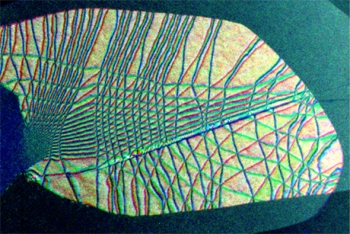Just an atom thick, 200 times stronger than steel and a near-perfect conductor, graphene’s future in electronics is all but certain. But to make this carbon supermaterial useful, it needs to be a semiconductor – a material that can switch between insulating and conducting states, which forms the basis for all electronics today.
 Three dark field-transmission electron microscopy images of bilayer graphene are overlaid with colors to show diffraction angles. The lines are soliton boundaries. Source: Muller lab
Three dark field-transmission electron microscopy images of bilayer graphene are overlaid with colors to show diffraction angles. The lines are soliton boundaries. Source: Muller lab
Combining experiment and theory, Cornell researchers have moved a step closer to making graphene a useful, controllable material. They showed that when grown in stacked layers, graphene produces some specific defects that influence its conductivity.
On the experiment side, a research group has imaged and analyzed the structure and behavior of graphene sheets stacked one on top of the other, called bilayer graphene. The group, publishing online June 24 in Proceedings of the National Academy of Sciences, includes Paul McEuen, the Goldwin Smith Professor of Physics and director of the Kavli Institute at Cornell for Nanoscale Science; David Muller, professor of applied and engineering physics and Kavli co-director; and Jiwoong Park, associate professor of chemistry and chemical biology and Kavli member.
They showed that instead of flat sheets of repeating carbon atoms arranged like chicken wire, when graphene grows layers, it ripples, like wall-to-wall carpet exceeding room dimensions. These ripples, called solitons, are like electrical highways that allow electrons to shoot from one end of the sheet to the other. The rest of the non-rippled graphene, when stacked, is semiconducting.
Previously, theorists had predicted that bilayer graphene would be uniformly semiconducting when stacked and staggered – the way a sheet of billiard balls would stack if the balls (atoms) were nestled in the in-between spaces. But the theory didn’t pan out, and the Cornell researchers now contend it is because of the solitons.
“People thought graphene was perfectly stacked everywhere, but in truth it has these funny structural solitons that give rise to electronic, one-dimensional channels,” McEuen said. “All these complexities were hiding.”
A separate research group led by Eun-Ah Kim, assistant professor of physics, published a paper the same week in Physical Review X that describes the mathematics and theory behind the electrical properties of the solitons and how they fit into the bilayer graphene picture that McEuen’s collaboration studied.
“Ideally, we would like to control graphene,” Kim said. “We would like to get rid of the solitons, or maybe we would want to make a well-controlled, one-dimensional electrical highway but not have so many of them. If we figure out how to control graphene, control where the solitons are, we can open up new ways of controlling bilayer graphene.”
The paper led by McEuen, “Strain Solitons and Topological Defects in Bilayer Graphene,” included work by graduate students Jonathan Alden, Wei Tsen and Pinshane Huang. It was supported by the Air Force Office of Scientific Research and the National Science Foundation.
The paper led by Kim, “Topological Edge States at a Tilt Boundary in Gated Multilayer Graphene,” included work by postdoctoral associate Abolhassan Vaezi, graduate student Darryl Ngai, and Yufeng Liang and Li Yang of Washington University. Their work was also supported by the National Science Foundation, including an NSF CAREER grant.